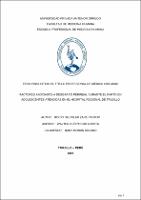| dc.contributor.advisor | Olórtegui Acosta, Walter | |
| dc.contributor.author | Zare Pastor, Rocío del Pilar | |
| dc.creator | Zare Pastor, Rocío del Pilar | |
| dc.date.accessioned | 2020-03-05T15:57:04Z | |
| dc.date.available | 2020-03-05T15:57:04Z | |
| dc.date.issued | 2020 | |
| dc.identifier.uri | https://hdl.handle.net/20.500.12759/6062 | |
| dc.description.abstract | Material y Métodos: Se realizó un estudio analítico, observacional, casos y controles,
retrospectivo en una muestra de 172 gestantes adolescentes sin desgarro perineal
y 43 gestantes adolescentes con desgarro perineal, atendidas en el Hospital Regional
De Trujillo del 2013 – 2017. Para el análisis de la asociación de variables bivariado se
usó la prueba Chi cuadrado de Pearson y también se midió la medida de riesgo con su
respectivo intervalo de confianza del 95%, del resultado del análisis bivariado se
consideró las que son significativos (p< 0,005) en el análisis multivariado (Regresión
logística múltiple) la cual nos sirvió como modelo predictivo.
Resultados: Nuestro grupo casos y nuestro grupo control fueron relacionados con 5 variables; la episiotomía resultó estar asociada a desgarro perineal como factor protectoren gestantes adolescentes (p= 0.000; OR 0,040); también se encontró una asociaciónsignificativa entre el número de partos vaginales y el desgarro perineal, las multíparastuvieron un riesgo 5 veces mayor para presentar desgarro perineal (p = 0,000; OR: 5,49);por otro lado la duración de la fase activa (p=0,420; OR:0.71), el peso del recién nacido(P=0.239), el personal que atendió el parto (p= 0.122) no estuvieron asociados a desgarroperineal, tampoco fueron factor de protección para desgarro perineal.
Conclusión: Los factores que están asociados a desgarro perineal son el número de
partos vaginales y la episiotomía como factor protector para desgarro perineal. El peso
del recién nacido, la duración de la fase activa, el personal que atendió el parto no están
relacionados a desgarro perineal. | es_PE |
| dc.description.abstract | To determine the factors associated with perineal tear in adolescents in the
Trujillo Regional Teaching Hospital.
Material and Methods: An analytical, observational study, cases and controls were
conducted, retrospective in a sample of 172 pregnant teenagers without perineal tear
and 43 pregnant teenagers with perineal tear, treated at the Regional Hospital From
Trujillo from 2013 - 2017. For the analysis of the association of bivariate variables,
Pearson's Chi-square test was used and the risk measure was also measured with its
respective 95% confidence interval of the result of the bivariate analysis, the bivariate
analysis was considered. which are significant (p <0.005) in the multivariate analysis
(Multiple logistic regression) which served as a predictive model.
Results: Our case group and our control group were related to 5 variables; the
episiotomy was found to be associated with perineal tear as a protective factor in
adolescent pregnant women (p = 0.000; OR 0.040); a significant association was also
found between the number of vaginal births and the perineal tear, the multiparous
women had a 5 times greater risk of presenting perineal tear (p = 0.000; OR: 5.49); on
the other hand, the duration of the active phase (p = 0.420; OR: 0.71), the weight of the
newborn (P = 0.239), the personnel who attended the delivery (p = 0.122) were not
associated with perineal tear, nor were they protection factor for perineal tear.
Conclusion: The factors that are associated with perineal tear are the number of
vaginal births and episiotomy as a protective factor for perineal tear. The weight of the
newborn, the duration of the active phase, the personnel who attended the delivery are
not related to perineal tear. | en_US |
| dc.description.uri | Tesis | es_PE |
| dc.format | application/pdf | es_PE |
| dc.language.iso | spa | es_PE |
| dc.publisher | Universidad Privada Antenor Orrego | es_PE |
| dc.relation.ispartofseries | T_MED.HUMA_2738 | |
| dc.rights | info:eu-repo/semantics/openAccess | es_PE |
| dc.rights.uri | https://creativecommons.org/licenses/by/4.0/ | es_PE |
| dc.source | Universidad Privada Antenor Orrego | es_PE |
| dc.source | Repositorio Institucional - UPAO | es_PE |
| dc.subject | Desgarro perineal | es_PE |
| dc.subject | Peso del recién nacido | es_PE |
| dc.title | Factores asociados a desgarro perineal durante el parto en adolescentes atendidas en el Hospital Regional de Trujillo | es_PE |
| dc.type | info:eu-repo/semantics/bachelorThesis | es_PE |
| thesis.degree.level | Título Profesional | es_PE |
| thesis.degree.grantor | Universidad Privada Antenor Orrego. Facultad de Medicina Humana | es_PE |
| thesis.degree.name | Médico Cirujano | es_PE |
| thesis.degree.discipline | Medicina Humana | es_PE |
| dc.subject.ocde | https://purl.org/pe-repo/ocde/ford#3.02.27 | es_PE |
| renati.type | https://purl.org/pe-repo/renati/type#tesis | es_PE |
| renati.level | https://purl.org/pe-repo/renati/level#tituloProfesional | es_PE |
| renati.discipline | 912016 | es_PE |
| dc.publisher.country | PE | es_PE |


